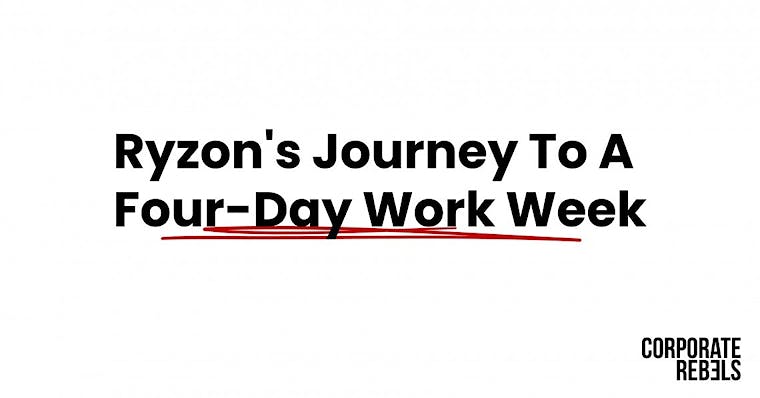Ryzon's Journey To A Four-Day Work Week

When building a new company, few think about ‘a compensation model'. Neither did we. As a young company, we only looked at issues when they became difficult—and then called them growing pains. Compensation became painful in the fall of 2020. So, we tackled it, and a global pandemic, simultaneously.

We had planned to ’tame’ this issue with an ingenious model of 5 salary levels, a bonus here and there and a few benefits. It failed.
We realized it was not easy to oversee the whole organization and individuals at the same time. So, we asked: How fast is the structure changing in our company? This helped us realize that, to develop quickly, the compensation model would have to evolve too. Put differently, we need a permanent beta version.
We looked at the topic holistically, focusing on more than just compensation and benefits.
As a small company, we act “naturally” on a daily basis. For example, we play sports as a group and share meals. No one tracks work hours. But once we grew to more than 20 employees, it was difficult to create an organization structure that addressed all concerns.
After much discussion, a model with three pillars emerged that reflects our commitment to human-centric work. The three pillars?
- Happiness at work as the foundation
- Salary as a way to show appreciation and give job satisfaction
- Ryzon support for our team
Support and Salary to show appreciation and give job satisfaction
We wanted to compensate in line with the market, but what does that mean? How can an internet statistic relate to the current status of the company? And, what does it mean in the context of a total compensation model?
If you simply adopt market conformity, failure is almost inevitable. But we still need numbers as a first step. So, we adopted median salaries as a reference for base salaries. Then we considered things like years at Ryzon, other experience, and company profitability as determinants of the final salary.
This is not perfect. Market data is just a starting point. But it adds transparency to the process.
We want to support employees at various levels. As well as membership in a platform for sports courses, we want all to be able to buy our products at a discount, order books free of charge, and participate in training courses for development.
Happiness as the foundation — a four-day work week
The core of the new model offers a basis for self-worth and self-reflection relating to duties. Adequate pay cannot be neglected, but I’m convinced employees don’t stay with a company only for monetary reasons. They stay when work is fun, meaningful and fulfilling.
Many things we value had already been adopted, like social responsibility, being a driver of innovation, and a work environment of humanity and trust.
For example, sport unites our employees and is played at all times. We encourage people to engage in physical activity during work hours. A sports meeting is often more valuable than one in a closed room, or on a computer.
Like many, we have worked predominantly from home for over a year. We will continue with a hybrid model where everyone can work regardless of time and place. Everyone has role-based accountabilities, so there are no controls on how many hours are completed, as long as the work is done. We are repaid for this trust when employees independently initiate great projects they think will move the company forward.
The big development for us is a four-day week, on the same salary. And questions arise: Is this economically, right? Can all employees handle the same workload? I had this question, because I’m used to working 40 hours a week. But if you think about it, it's bullshit. We invented nine-to-five and five days a week, and therefore, we can get rid of them.
Most companies unwittingly encourage time-killing because it is “paid.” This is normal, and we have played the same game. Accepting the existing system is easier, even though we are convinced the best ideas are usually not generated at a desk—only recorded there.
But how do you introduce a four-day/32-hour week? The easiest way is to take a day out of the week.
But this creates a problem because it still requires an eight-hour work schedule. And this would be counterproductive. Long work days in which you can’t concentrate all the time would be inevitable.
So, to make change possible we are using a bridge called a “32 hour” work week.
In day-to-day activities, we don’t measure working hours, and many employees often work more than 40 hours a week. But with the new “32 hour” model, we want to make ourselves more aware of this, and address the issue structurally.
We want to learn what a four-day week can look like for Ryzon, and have started an experiment. We want to focus on four to six hours of efficient and productive work per day. We hope this will support a positive cycle of relaxation and stimulation that can be maintained over the long run.
Outcome-based work should be the focus. Employees can distribute their 32 hours throughout the week as they wish
The beginning of a journey
We now see the question of compensation has more impact than we wanted to admit. It has taken us on a completely new journey, culminating in a four-day week.
How will this experiment turn out? How will each person and team adapt? In the fall, we will give ourselves feedback and use it as the basis for more adaptation. I am certain we will continue to evolve.
Reflecting on Ryzon’s early years, I smile. What an exciting journey of ups and downs it has been. The journey continues.
This is a guest post from Felix Erdmann, Teamlead People & Culture at Ryzon. For more information on Felix and the company, check out his rebel page.





